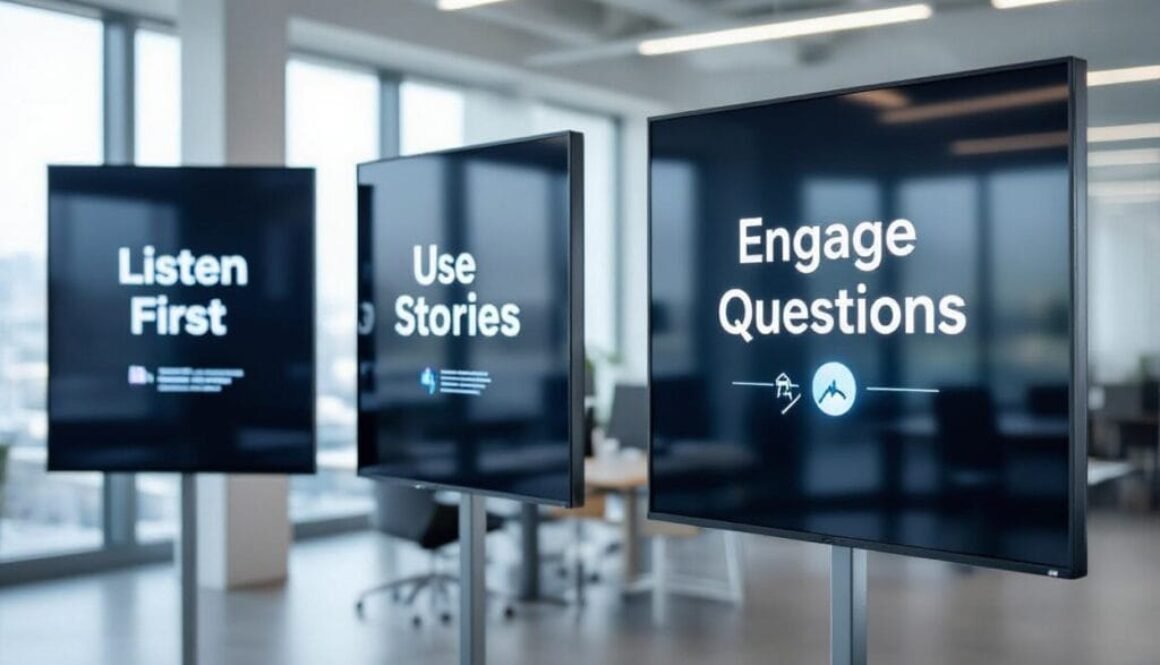To command attention and influence people, use 5 simple phrases
Harnessing Simple Phrases to Captivate Audiences
Practical application
I coach executives at Your Career Place to use those five phrases in short presentations: one client cut decision time from 20 to 7 minutes by opening with “Our options are A, B, C. My recommendation is…”, and another turned a stalled pilot into a $2M program by saying “Which means…” to tie activities to outcomes. At Your Career Place I teach you to name stakeholders, state timelines, and finish with “What we need next is…” so meetings end with clear ownership and deadlines.
Key Takeaways:
- Lead with options and a clear recommendation — present A, B, C and then say which you pick. At Your Career Place we find this trims confusion and makes you sound decisive without sounding pushy.
- State what you see and tie it to outcomes — use phrases like “Here’s what I’m seeing…” and “Which means…” to turn tasks into business impact so others grasp why it matters.
- Be specific about next steps and probe reactions — say “What we need next is…” and ask “What’s behind your reaction?” Your Career Place coaches leaders to be direct, curious, and action-oriented so you get faster buy-in.
Unlocking the Power of Options
I teach leaders at Your Career Place to stop offering open-ended input and instead present limited, labeled choices. Over 15 years coaching at Google, Amazon and in workshops with 200+ managers I’ve seen meetings move from stalled to decisive once options are framed clearly. Three alternatives keep dialogue focused, help stakeholders compare trade-offs, and give you permission to lead with a recommendation.
The phrase that clarifies choices: “Our options are A, B, and C. My recommendation is…”
Use the line exactly and follow with one-line summaries: A: save $50K but adds 6 weeks; B: launch on time at moderate cost; C: premium quality with higher margin. I say what each option means for cost, time, and risk, then state my pick. This signals confidence, limits endless hypotheticals, and makes it easy for others to agree or counter with a specific alternative.
How this statement frames decision-making
By naming options I narrow the decision space and set evaluation criteria up front. In a product review I run, proposing three trade-offs turned a 45-minute debate into a clear vote in 10 minutes because stakeholders could map choices to KPIs—revenue, launch date, customer satisfaction. You set the comparison axes so the conversation moves from diffuse opinion to concrete trade-offs.
I coach a simple template at Your Career Place: label each option, list one primary benefit, one downside, and the expected metric change (cost, weeks, NPS). Example: A saves $50K, -6 weeks; B meets deadline, +2% revenue; C boosts NPS by 5 points at +$80K. That structure prevents rehashing, forces trade-off thinking, and makes your recommendation straightforward to endorse or reject.

Painting the Picture: Observations that Engage
I teach leaders at Your Career Place to open with tight, evidence-based observations that orient a room in 1–2 sentences. I’ve spent 15 years coaching teams at Google, Amazon, and Fortune 500s, and I’ve found that a single concrete fact—“customer churn rose 3% this quarter”—anchors attention faster than narrative. Use a metric, a visual cue, or a brief incident to give people something real to react to, then move quickly to what that implies.
Using “Here’s what I’m seeing…” to draw attention
Use “Here’s what I’m seeing…” to separate fact from opinion and to claim the floor without sounding defensive. I tell clients to follow that lead with one metric or observable behavior—like “support tickets doubled after the release”—and one short implication. In my workshops at Your Career Place, that phrasing routinely converted passive listeners into active questions within 30–60 seconds, speeding decision cycles and reducing off-topic debate.
The impact of observational narratives on listener connection
Observational narratives lower barriers: I notice people stop arguing about intent and start solving for outcomes when I state what I observe. Statements grounded in data or concrete scenes invite others to add context—executives ask clarifying questions, managers propose fixes—and the room aligns around shared evidence rather than assumptions.
Digging deeper, the mechanics are simple. Observations act as anchors that reduce ambiguity, create a common frame, and make asking for input feel natural instead of confrontational. I coached a product manager to say, “Here’s what I’m seeing: daily retention dropped 6% after the last release,” then add, “which means our monthly revenue could decline if we don’t act.” That two-part move turned a diffuse meeting into a prioritized action plan within one hour.
Connecting Dots: The Importance of Meaning
I focus on converting actions into measurable outcomes so your audience sees value immediately. At Your Career Place I tell clients to quantify results: “reduced support tickets by 27%,” “saved 120 engineering hours,” or “accelerated sales cycle by 14 days.” Those specifics turn tasks into business language decision-makers understand, and they shift perceptions from task-doer to impact-driver.
The significance of the phrase “Which means…”
I use “Which means…” to bridge work and consequence. Saying “I launched the onboarding flow, which means a 30% drop in first-week churn” translates activity into strategic value. I’ve seen this single phrase reframe resumes, meeting updates, and slide decks at Your Career Place, making outcomes the headline instead of the footnote.
Building understanding and anticipation through clarity
I craft messages so leaders know the current state, the consequence, and the next ask in seconds. In my 15 years coaching at Google, Amazon, and other Fortune 500s I learned executives respond to concise frames: problem, net impact (use a metric), and one clear next step. That structure reduces back-and-forth and accelerates approvals.
Start with a one-sentence headline: the outcome. Follow with two evidence points—metrics, timelines, or customer quotes—and close with a specific request: who does what by when. I coach people at Your Career Place to use this 3-line template in emails and meetings; it routinely shortens decision cycles from weeks to days.

Mapping the Path Forward
I map the path forward by breaking decisions into milestones, owners, and dates so you can see exactly who does what and when. In practice I ask for a 90-day roadmap with three milestones, one owner per milestone, and a clear metric for success. At Your Career Place I use this template in workshops to turn vague ideas into executable plans that stakeholders can sign off on quickly.
Communicating action-oriented plans with “What we need next is…”
I phrase the next step as owner + deliverable + date: “What we need next is Maria to approve the budget by Thursday so PMs can start the sprint.” I coach leaders to keep requests single-action and measurable; avoid laundry lists. Using this at Your Career Place meetings reduced back-and-forth and made approvals faster because decision-makers knew the precise ask and timeline.
The role of forward-thinking statements in leadership
I use forward-looking statements to align teams around outcomes and to test assumptions before work begins. Phrases like “By Q4 we’ll aim to lift retention 10% by improving onboarding” set a north star, invite trade-off discussions, and force explicit metrics. In my coaching with Google and Amazon leaders, that clarity turned ambiguous debates into measurable experiments and faster decisions.
I instruct leaders to convert broad statements into three artifacts: a one-sentence outcome, two leading indicators, and a single owner. For example, “Increase trial-to-paid conversion to 8% in 90 days” pairs with weekly metrics, two A/B tests, and a product owner; run biweekly reviews to course-correct. That structure I used in a program cut decision cycles from weeks to days and kept stakeholders accountable.
Delving Deeper: Exploring Emotional Reactions
I treat emotional reactions as data: they signal hidden priorities, past experiences, or power dynamics. In my 15 years coaching 200+ leaders at Google, Amazon and through Your Career Place, probing feelings unearthed blockers in roughly 40% of stalled projects. I teach you to shift from debating positions to diagnosing motives—so you can adjust timelines, reframe asks, or reassign ownership instead of doubling down on a failed approach.
Inviting reflection with “What’s behind your reaction?”
I use that question to move conversations from surface disagreement to discovery. In a 2019 product-review meeting, asking “What’s behind your reaction?” uncovered a hidden vendor constraint and a past failed pilot, which reframed the discussion and reduced scope by one phase rather than escalating. You get specific objections, not defensiveness, and those specifics let you craft precise solutions instead of guessing.
Cultivating empathy and understanding in conversations
Empathy is tactical: I teach mirroring, labeling, and calibrated pauses so you can lower defenses and accelerate problem-solving. In workshops at Your Career Place, participants shift tone within two exchanges by saying things like, “You sound worried about the timeline,” then pausing for 20–30 seconds. That short pause often yields the real constraint—budget, capacity, or politics—so you can respond with a targeted next step.
Start with a three-step script I use in coaching: label the emotion (“You seem frustrated about the deadline”), validate briefly (“Given the last sprint, that makes sense”), then ask a solution-focused question (“What would make this workable for you?”). Add a 30-second silence after the question to allow reflection. I applied this with a product director who initially said no to a scope increase; after labeling and pausing, they disclosed a resource gap and we redeployed two engineers, avoiding a three-week launch delay and turning a roadblock into a negotiated trade-off.
Final Thoughts
Putting the phrases to work
I recommend you test these five phrases in your next three meetings: open with A, B, C plus my pick in the first 60 seconds, state the outcome, then close with a specific next step. In 15 years coaching leaders at Google and Amazon I’ve seen this sequence shorten decisions and raise visibility for overlooked contributors; at Your Career Place we use short role plays to build that habit quickly.
Thank you for visiting Your Career Place. Here are some interesting articles.
https://yourcareerplace.com/lead-like-a-pro-managing-meetings-for-success/

